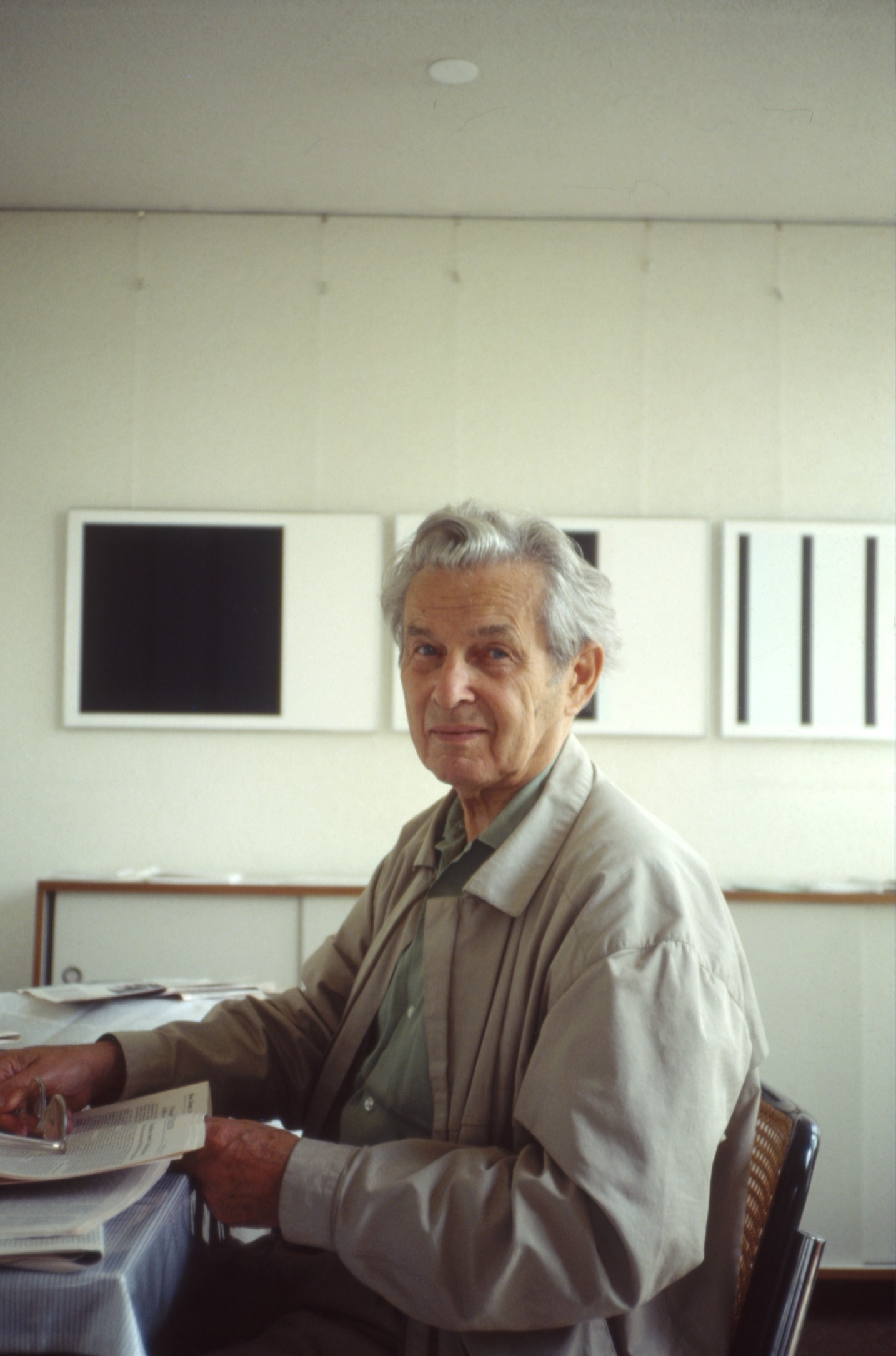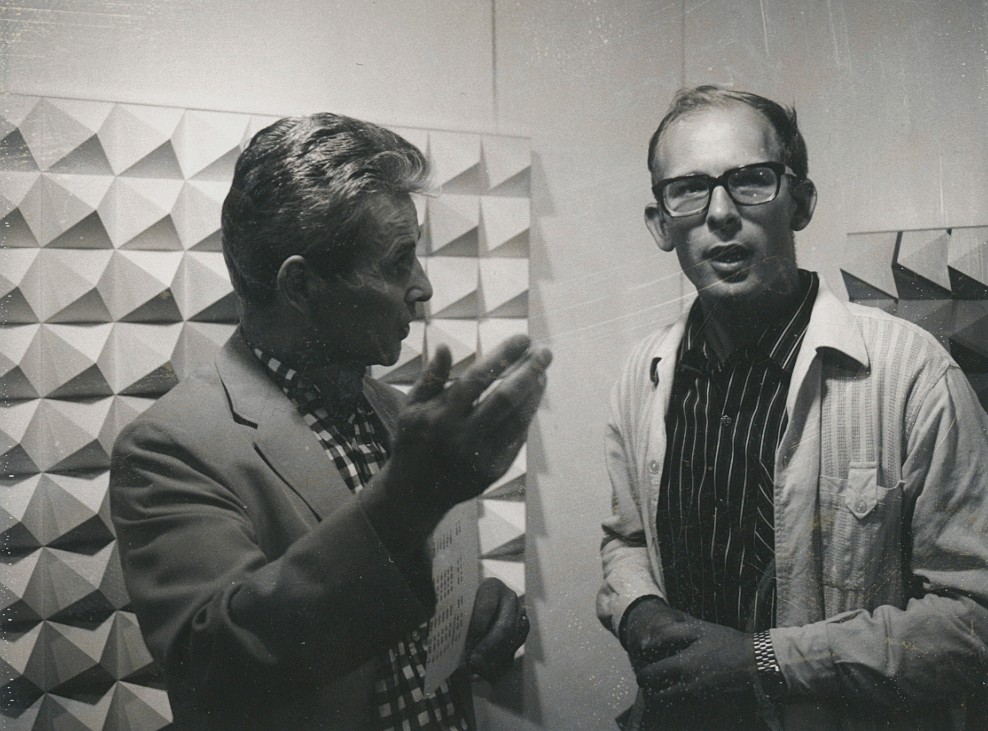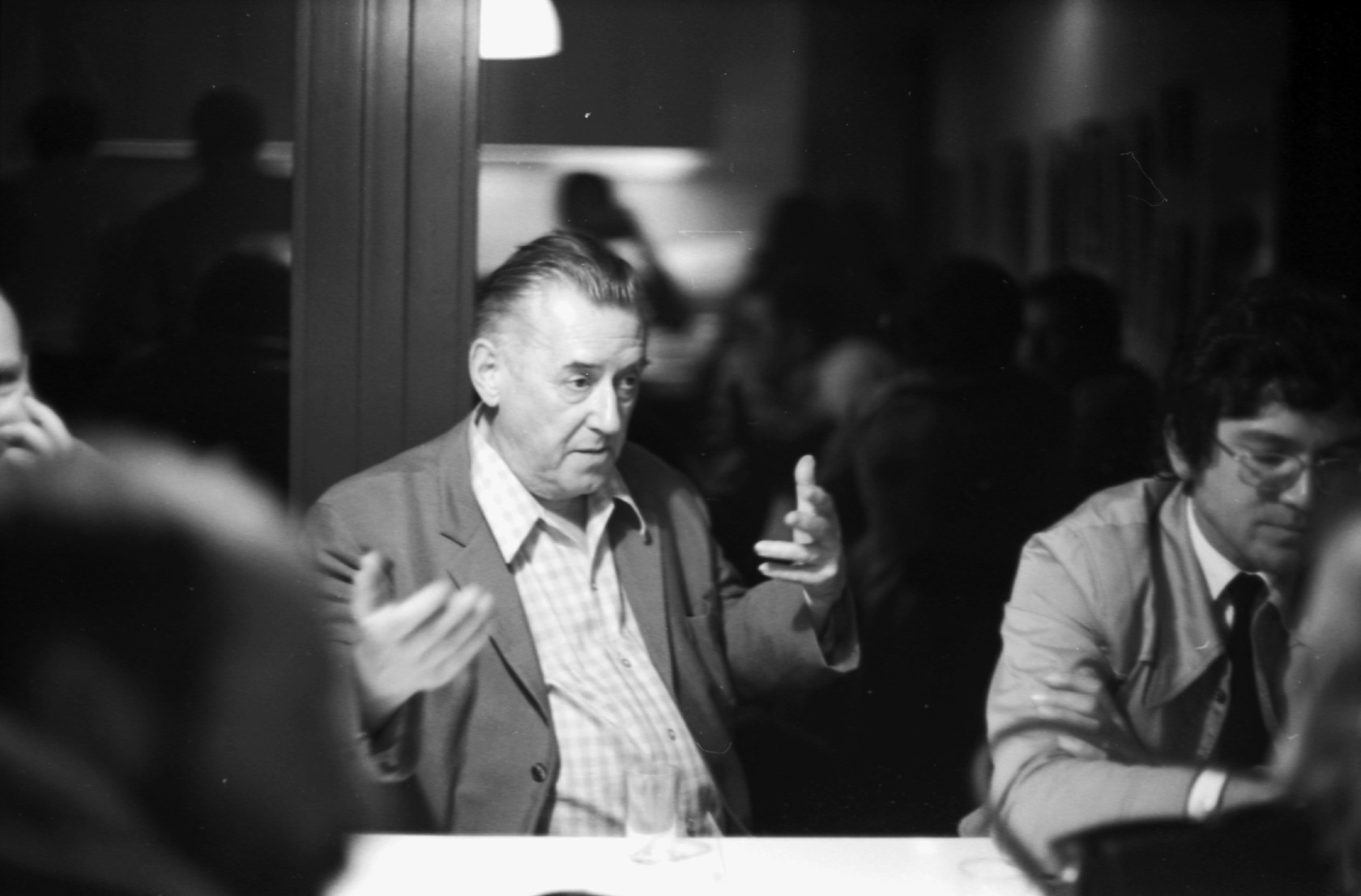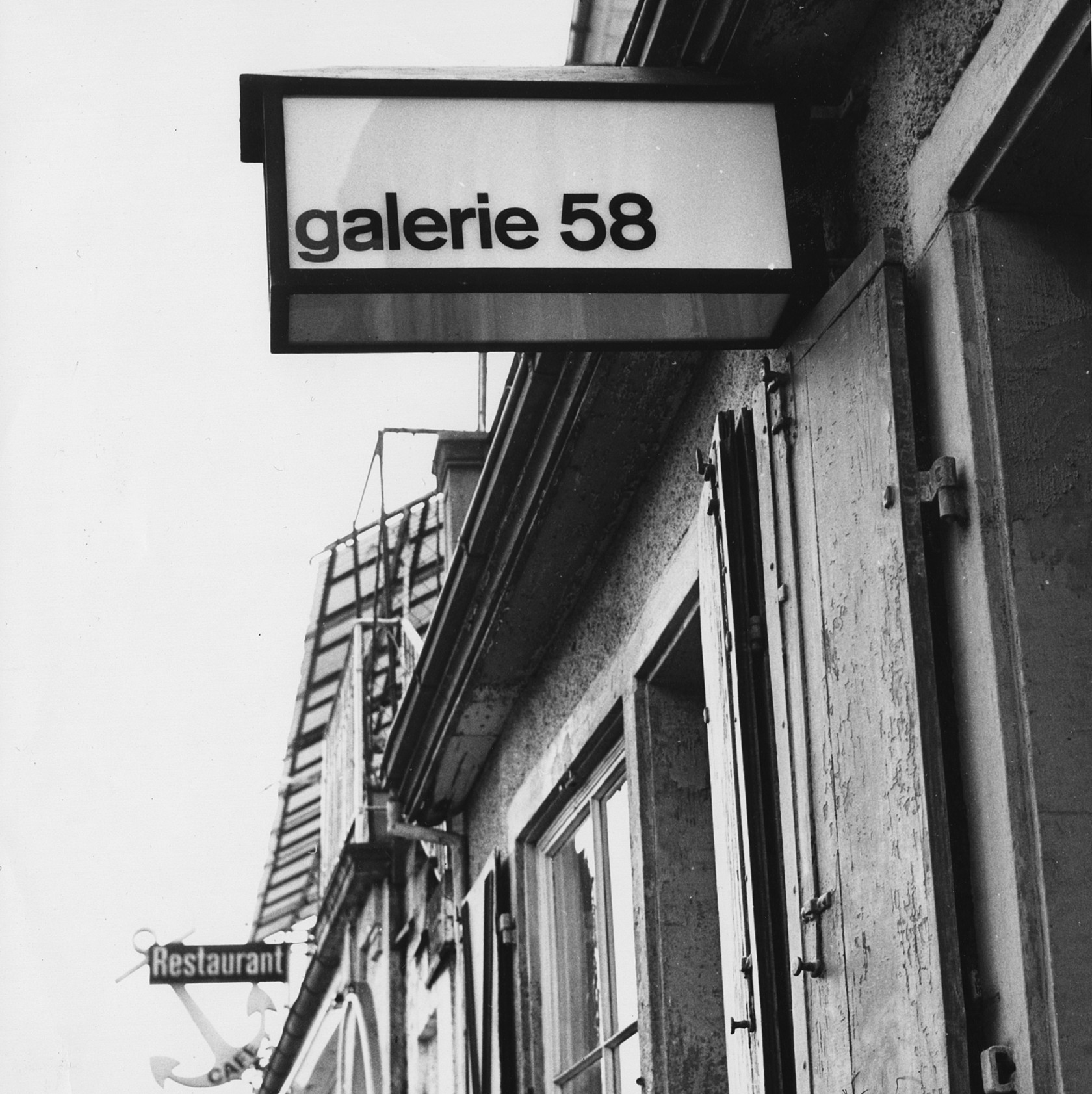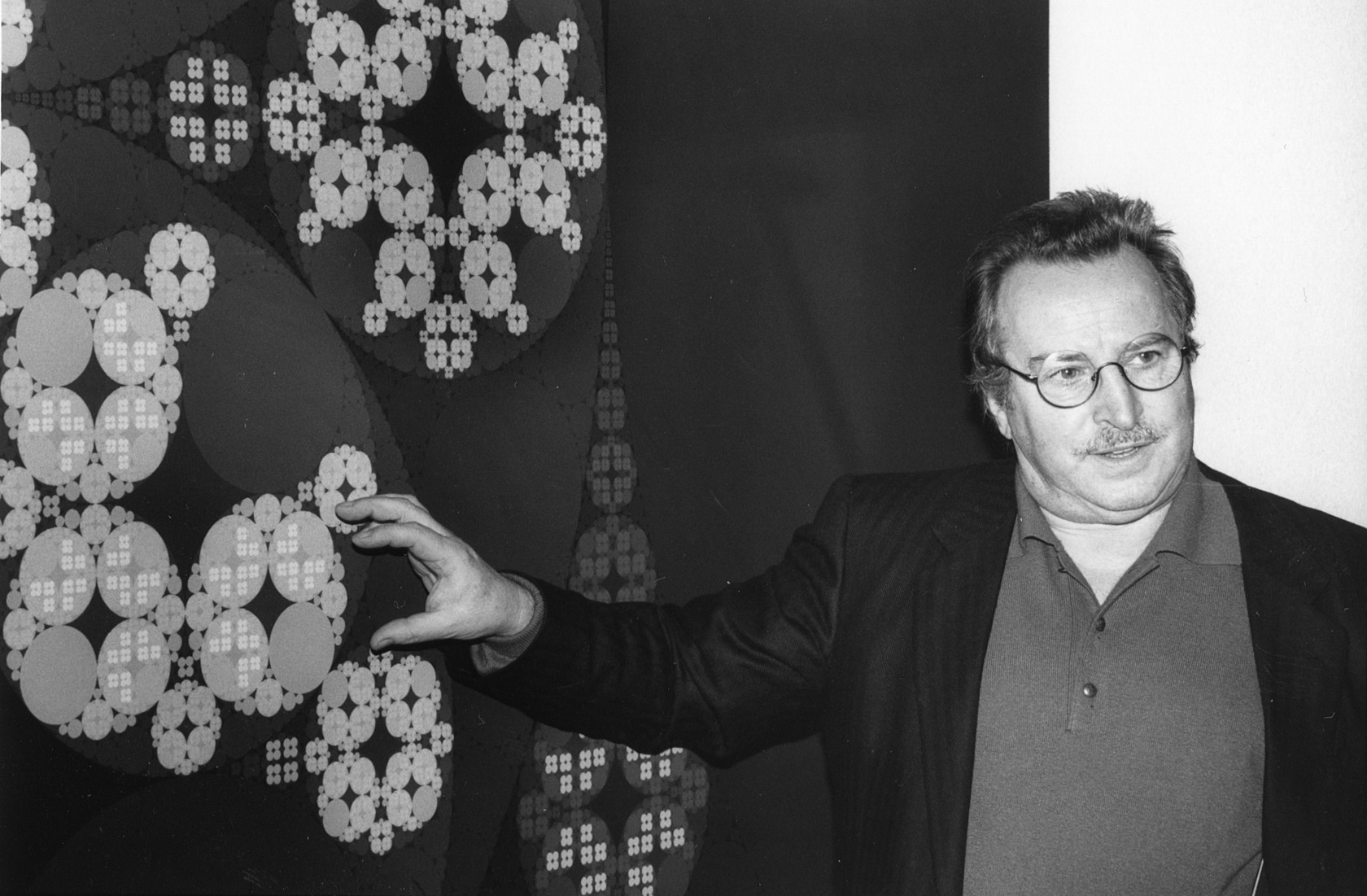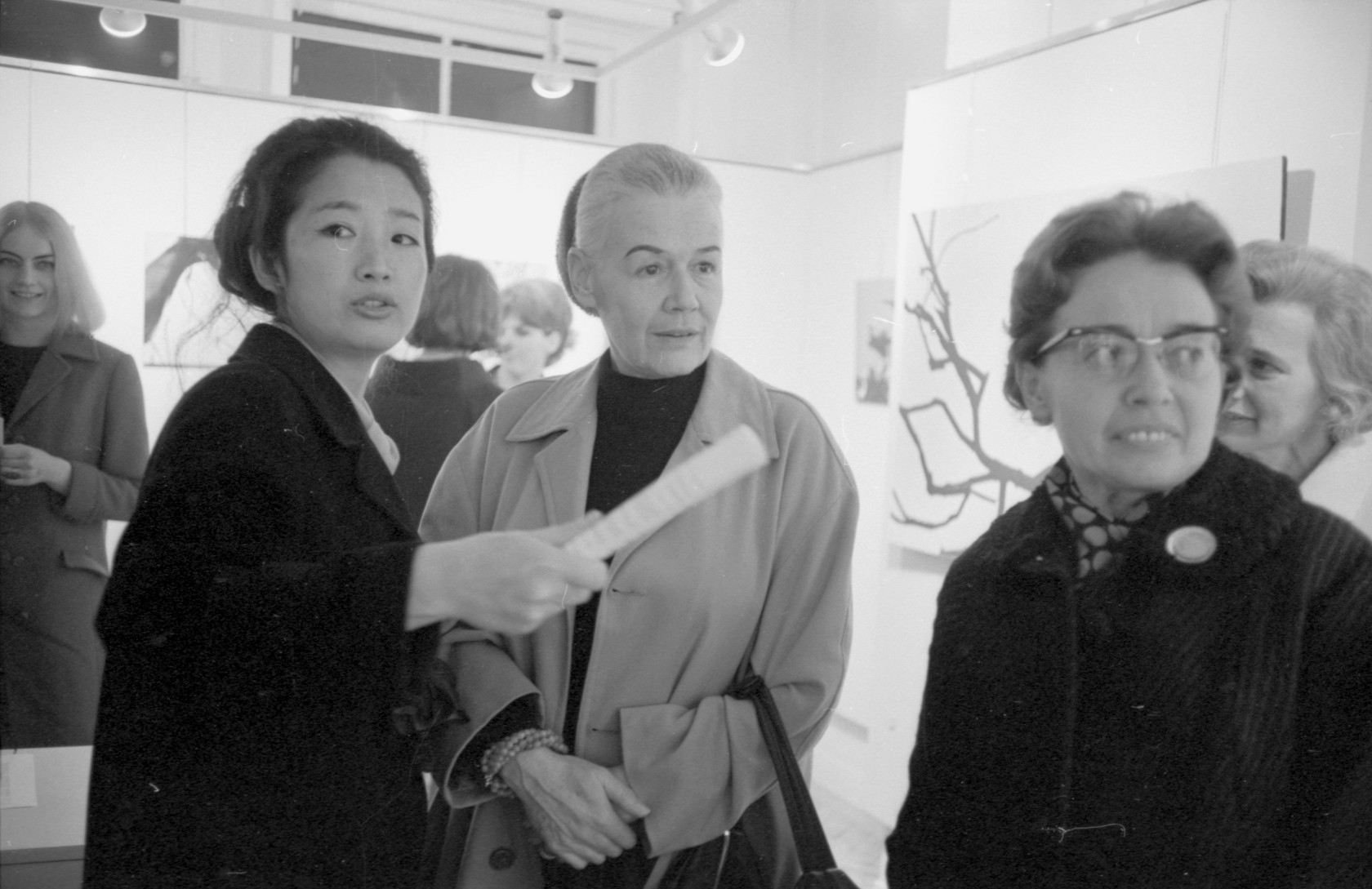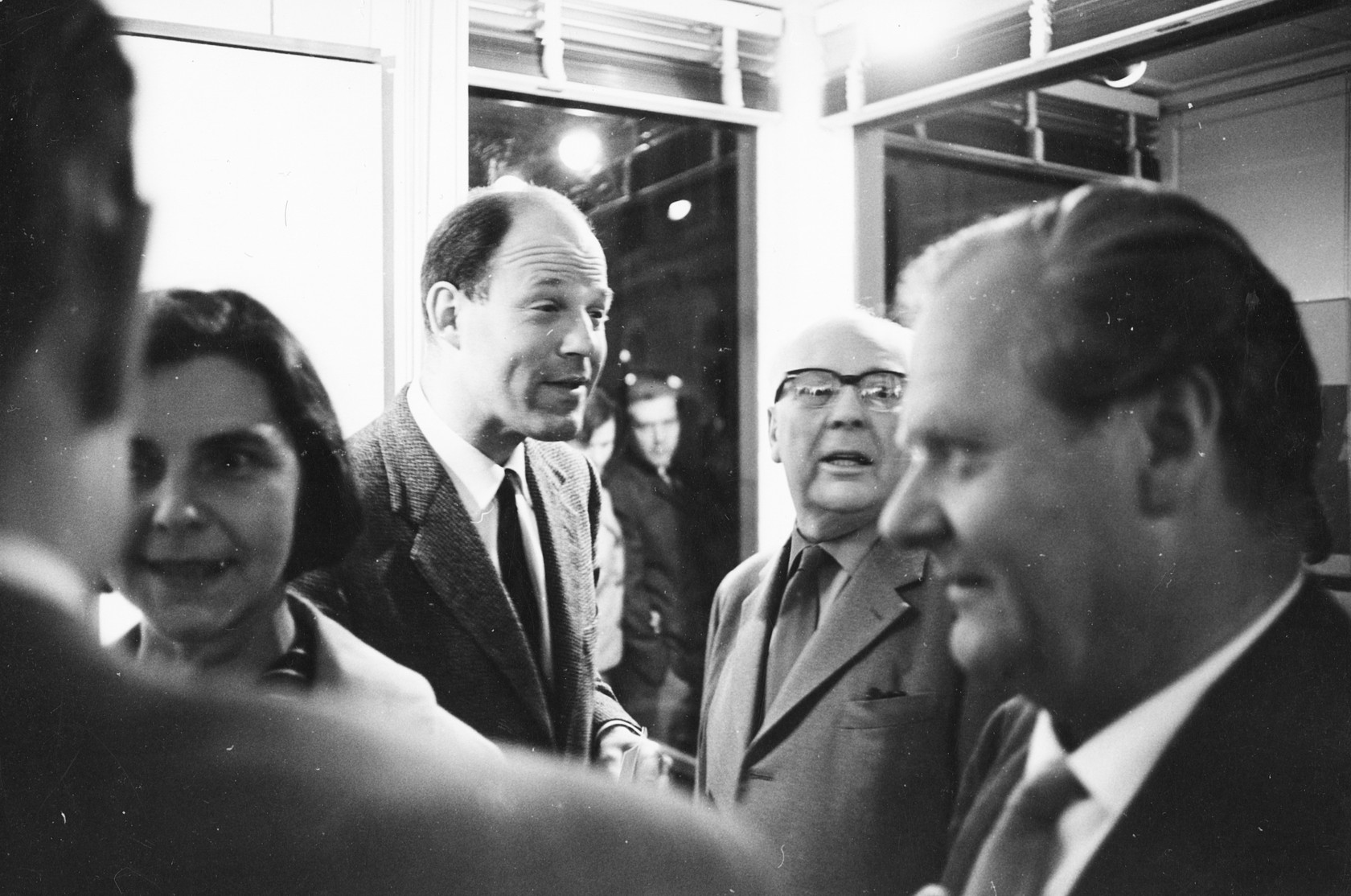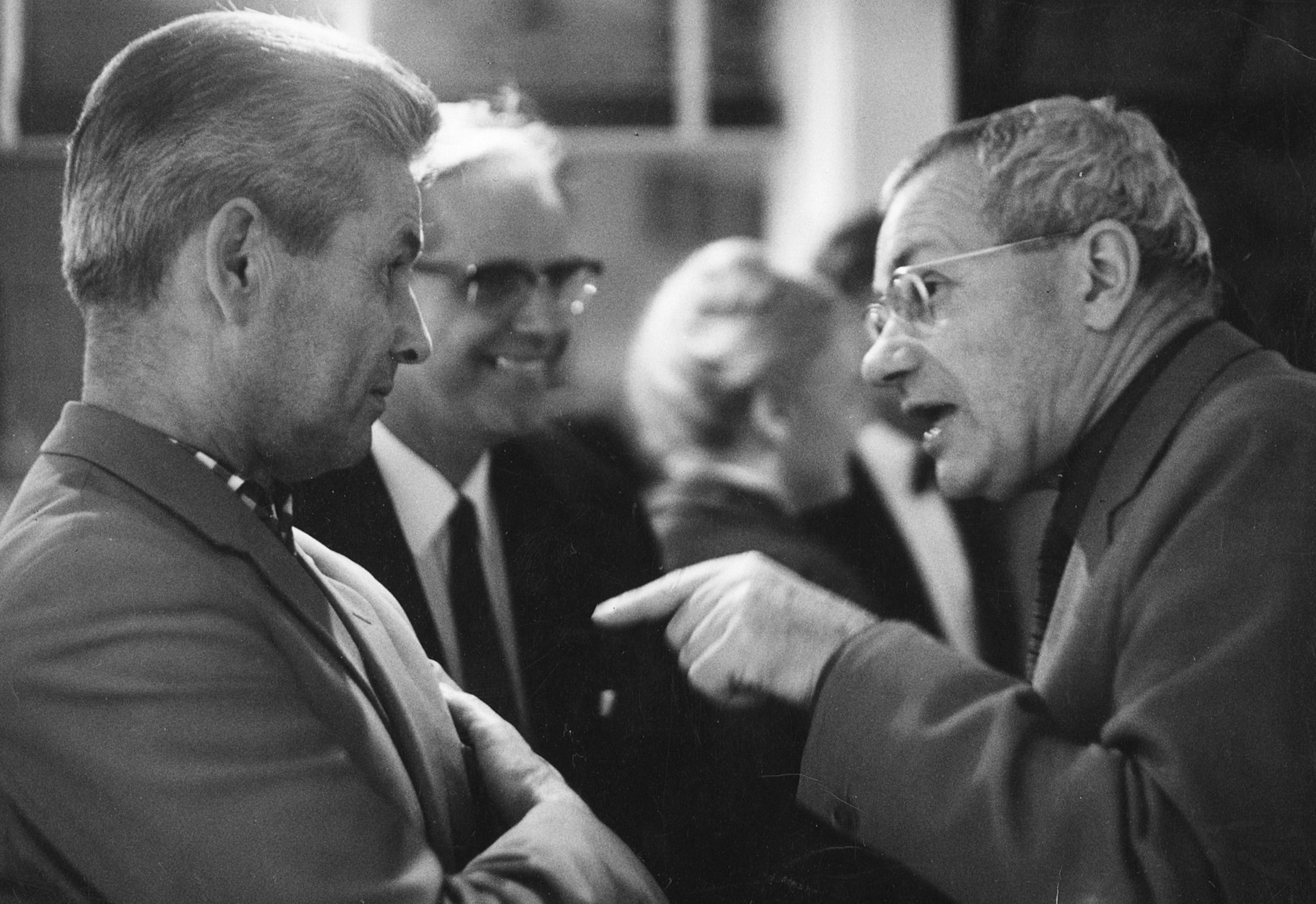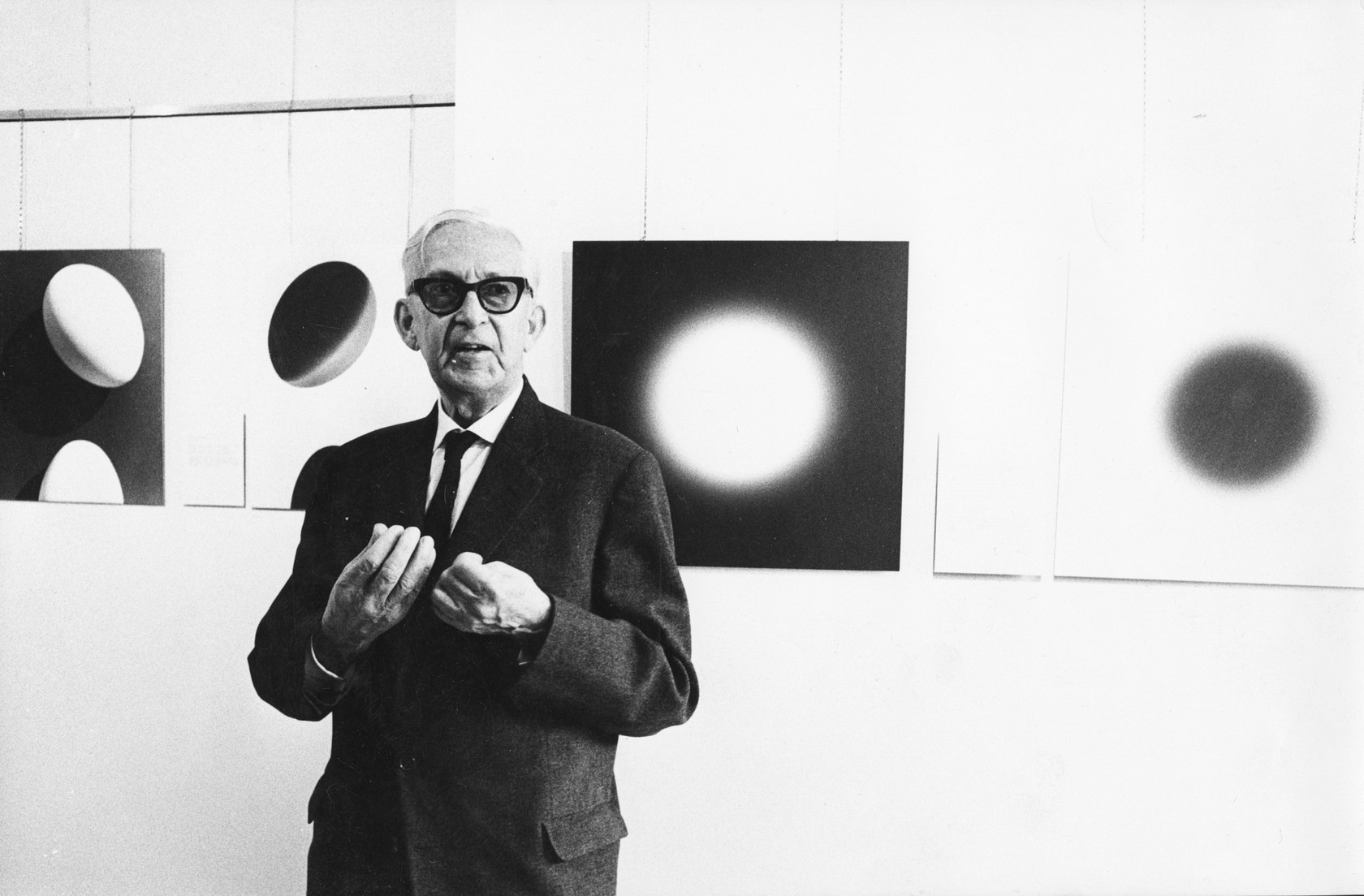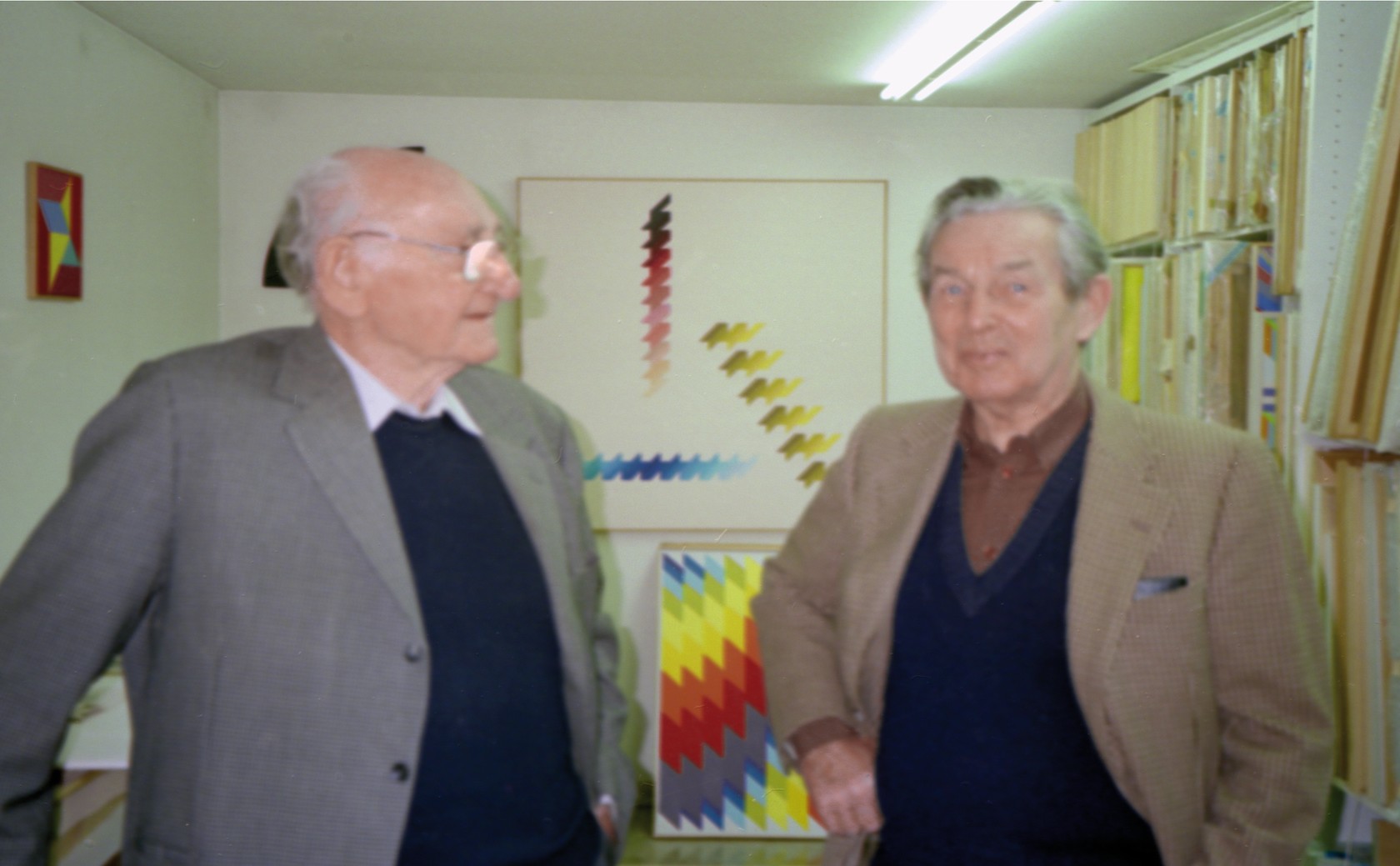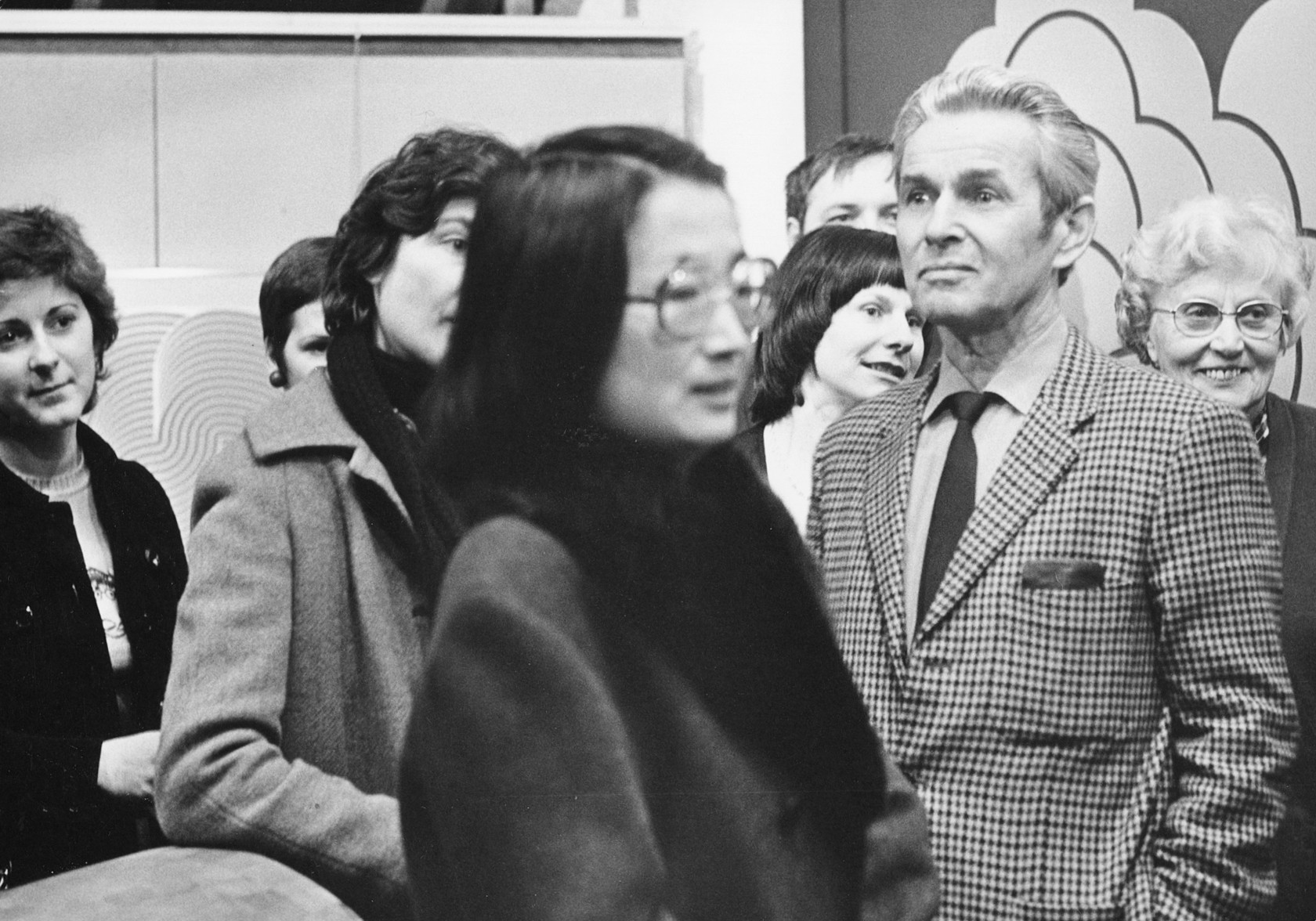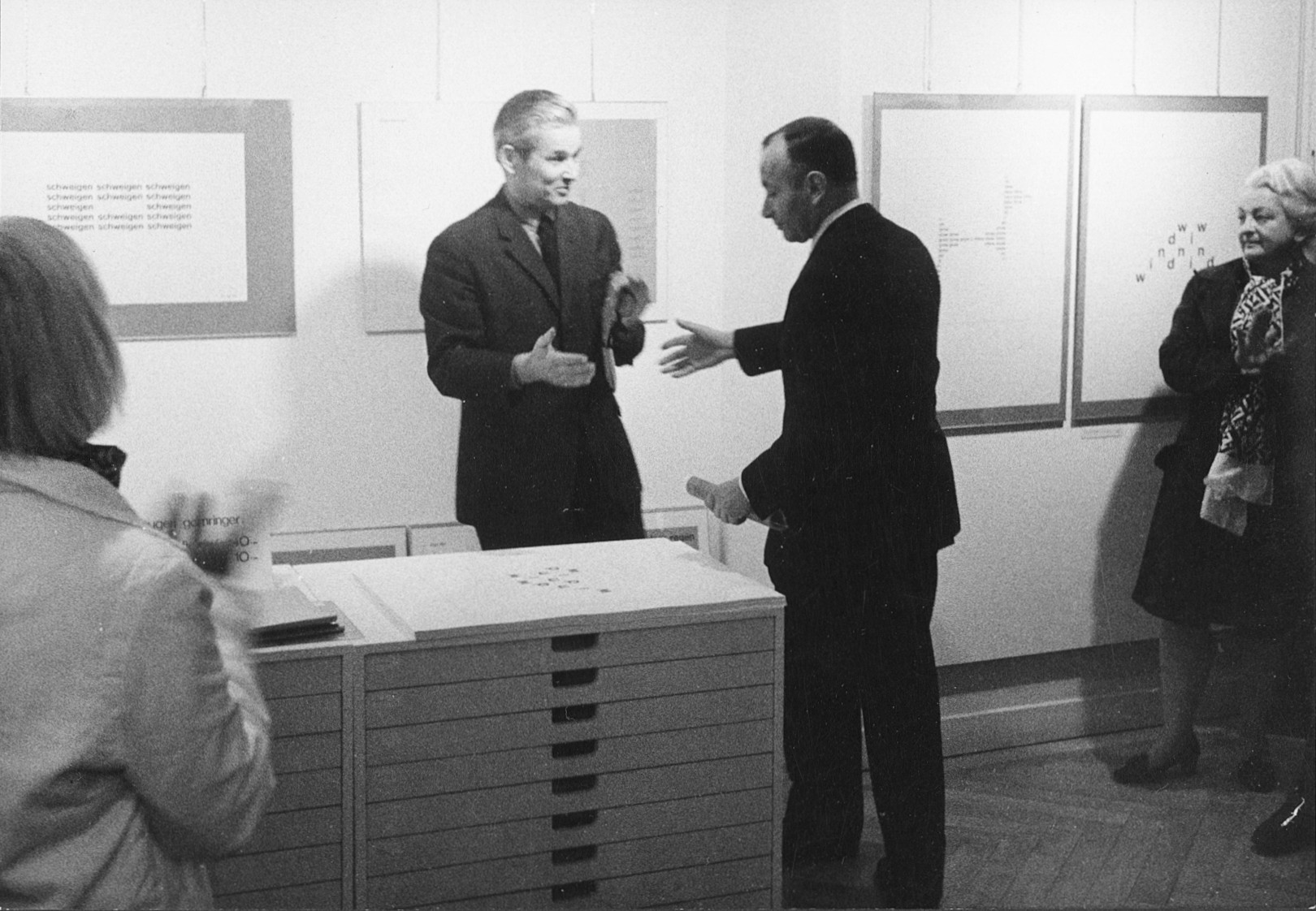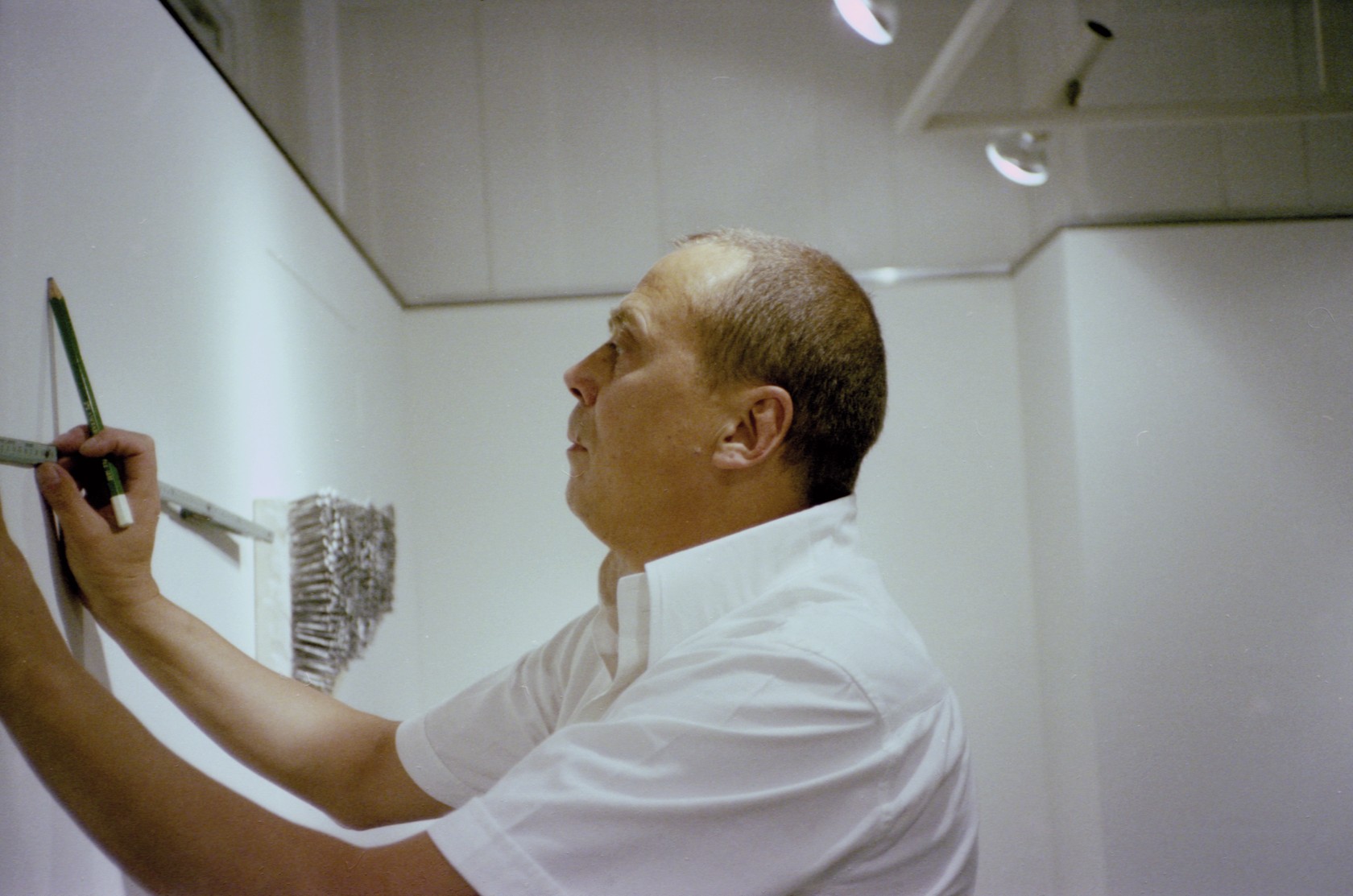THE GALLERY’S ACTIVITIES
In 1965 Josef Müller-Brockmann opened a gallery for modern art in Rapperswil with his architect friends Kurt and Eugen Federer. The name galerie 58 referredto the gallery of the same name that the Federer brothers had co-founded in 1958 in Restaurant Steinbock in Rapperswil, which they closed in 1961. The new galerie 58 was located in the house where Müller-Brockmann’s late mother had lived at Seestrasse 7, in an erstwhile umbrella shop that had been converted and extended to serve as a gallery. In 1974 the Federer brothers withdrew from the gallery business and were replaced by the architect Hermann Morf; at the same time Müller-Brockmann changed the gallery’s name to galerie seestrasse in1974. In 1990 the gallery in Rapperswil was closed and the business was continued in 1992/93 as galerie bergstrasse in amore modest setting in the home of Müller-Brockmann and Shizuko Yoshikawa at Bergstrasse 15 in Unterengstringen. In the autumn of 1993, the couple definitively gave up their gallery activities.
Initially, Müller-Brockmann focused the program on Constructivist art, including modern photography until 1969. In addition to strictly Constructivist approaches, he included a variety of Minimalist practices as well as Op Art. The exhibition program alternated between internationally recognized and largely unknown names, paying particular attention to the younger generation and to women artists. From 1965 to 1993, some 140 exhibitions were presented and around 80 prints were published. Rather than being commercially oriented, the gallery viewed its role as providing a forum for promotion, mediation and dissemination of constructive art. Thanks to its high-quality exhibitions and the editions it released, the gallery established a sound reputation over the decades as a widely respected complement to the municipal galleries in Zurich, Basel and Bern; it made a significant contribution to understanding and appreciation of Constructivist art.
THE EXHIBITION PROGRAM
Having incorporating photography (including work by Finsler, Groebli, Schulthess, Scheidegger) into the gallery program temporarily before 1969, Müller-Brockmann took a conscious decision to shift the focus entirely onto Constructivist-Concrete art. He stated in 1994: “My preference for this art movement is linked to my professional view: I admire Concrete artists’ ability to realize pictorial ideas without reference to the world of visible things, avoiding all elements not immediately required for understanding the idea. This attitude demands precise knowledge of the laws of form and color and great imagination.”1 He adhered to the elementary principles of Constructivism in his graphic design; his collaborator Shizuko Yoshikawa, who became his wife in 1967, created Constructivist art from the 1970s onwards, and there were also numerous contacts with artist circles involved with this movement. “Concrete and Constructivist art is an elitist affair and will probably remain so,”2 Josef Müller-Brockmann noted in 1994, although he felt duty-bound to represent it in his gallery to counterbalance prevailing aesthetic and ethical excesses.
The first year of the gallery program began with doyen Josef Albers and, in tribute to the generation of Swiss pioneers, with Zurich Concrete artists Max Bill, Camille Graeser, Verena Loewensberg and Richard Paul Lohse. The inaugural exhibition on July 12th 1965 presented work by Verena Loewensberg – the only woman among the Zurich Concrete artists – and Max Bill made the opening speech. The gallery’s reopening was widely acclaimed in the regional press. The Linth newspaper, for example, wrote: “Rapperswil is also pleased that J. Müller-Brockmann, a man with connections to the wider world, is running this gallery. In the next few weeks, people in this small town by the sparkling lake will have a chance to engage with the art of our time, which will offer a breath of cultural fresh air.”
Alongside strictly Constructivist approaches, the exhibition was designed to include a broader perspective encompassing Minimalist practices or optical phenomena (inter alia with work by Getulio Alvani, Hartmut Böhm, Karl Gerstner, François Morellet, Marcello Morandini) as well as Concrete Poetry (Eugen Gomringer, among others). In addition to exhibitions with internationally recognized artists of the older generation, including Josef Albers (1965), Friedrich Vordemberge-Gildewart (1966), Günter Fruhtrunk (1971), Auguste Herbin and Walter Dexel (1972), and Günther Uecker (1982), there were also presentations with a special focus on younger artists who were not yet established. In that spirit, drawing from Swiss artistic circles, the gallery introduced early shows by Jakob Bill, Andreas Christen and Nelly Rudin (1968), Hans Jörg Glattfelder (1969), Ulrich Elsener (1972), Christian Herdeg (1975), Heinz Müller-Tosa and Emil Müller (1976). The gallery’s close collaboration with Eastern Europe artists then virtually unknown in Switzerland was a clear exception to standard exhibition practice of that era; in this spirit, works by artists such as Marian Szpakovski (1969), Vjanceslav Richter (1972) or Ivan Picelj (1973) were shown in Switzerland for the first time. The Müller-Brockmanns placed a particular emphasis on providing a platform for female artists. Women were already in the minority in what was dubbed the “cold art” and encountered numerous difficulties in the art world. Female artists from Switzerland working in this style included Verena Loewensberg (1965, 1968, 1974, 1983), Nelly Rudin (1968, 1984), Shizuko Yoshikawa (1974, 1977, 1982, 1990), Marguerite Hersberger (1976), Elsa Burckhardt-Blum (1977), Elena Lux-Marx (1980), Hedi Mertens (1980), Jenny Losinger-Ferri (1981, 1988) and Rita Ernst (1990), with their counterparts from outside Switzerland including, for example, Marina Apollonia (1970), Kiki Vices Vinci (1978) and Gudrun Piper (1984). In addition to solo or joint shows, group exhibitions were held at irregular intervals, usually under a common theme. For example, in 1970 the gallery showed konkrete poesie (concrete poetry), in1975 and 1977 the internationale kleinformatausstellung (international small format exhibition) in 1978 konkrete kunst im postkartenformat (concrete art in postcard format), and in 1985, marking the gallery’s twentieth anniversary, the konkrete-konstruktive, (concrete-constructivist)series, conceived to span six exhibitions.
The gallery cooperated informally with other galleries, either representing the same artists or exchanging loans. There were closer links to Galerie Suzanne Bollag in Zurich, founded in 1958, which became an important stronghold for Constructivist artists even before they gained popularity in the 1960s, especially through Kinetics and Op Art. Constructivist art had largely led a niche existence in Switzerland, with hardly any exhibition opportunities until its gradual acceptance from the 1950s on. Galerie des Eaux Vives inZurich, founded by Hansegger, who was himself an artist, was one of the few exceptions during the war years. From 1942 to 1947, it was an important platform for the Constructivist artists as an exhibition venue and through its publishing activity, along with the artists’ group allianz, founded in 1937 as Vereinigung moderner Schweizer Künstler (Modern Swiss Artists Association).
PROMOTION OF EDITIONS
with the inaugural Verena Loewensberg exhibition in 1965. These editions aimed, on the one hand, to support the artists by releasing prints financed by the gallery and, on the other hand, to offer gallery visitors a chance to purchase comparatively inexpensive works. The artists’ role was to devise a design, which was generally also used in the exhibition poster. Prints were to measure 75 × 55 cm if possible and be hand-signed and dated by the artist. Each edition was limited to 150 copies, of which 20 went to the exhibiting artist and 130 to the gallery. In the beginning, four to five editions were released annually, but from the mid-1970s, the number of editions was gradually reduced, as sales did not live up to expectations or sufficiently offset the cost.
ADVERTISING AND PRESS RELATIONS
Particular emphasis was placed on a uniform corporate design for the gallery as well as professional press relations. The concept for the visual identity was designed by Müller-Brockmann and remained unchanged throughout the entire period that the gallery operated. As one would expect, the design for the large and small-format posters, invitation cards and advertisements in art journals, all in lower-case print, was exemplary and pared down to the essentials. The invitation cards were accompanied by introductory texts and, in some cases, transcripts of speeches given by experts, with a view to helping both the public and the press to understand the works on display. Since it soon became apparent that local newspapers in particular were out of their depth when it came to reviews of art movements that were difficult to grasp, Müller-Brockmann contacted experienced art critics to encourage them to write reviews or commissioned art historians to write what might be dubbed ‘reviewers by appointment to the court’.
FURTHER OUTREACH ACTIVITIES: EXTERNAL EXHIBITIONS AND ‘FRIENDS OF’ ASSOCIATION
Intending to expand its target audience, the gallery had a stand at ART Basel several times in the 1980s.3 For similar reasons, Müller-Brockmann arranged a series of exhibitions in two shopping malls: konstruktive kunst (constructive art) at the ABM Zentrum Rosenberg Winterthur (1974) and Shopping Center Spreitenbach (1975) as well as schweizer zeichnungen und grafik der gegenwart (swiss contemporary drawings and works on paper) at Zentrum Winterthur and Spreitenbach (1975). Despite the efforts4 involved in organizing these events, they did not produce the expected response. Müller-Brockmann enjoyed greater success in his collaborations with professional event organizers. These included the exhibitions swiss concrete art at IBM Gallery, New York (1967), zürcher konkrete (zurich concrete artists) at Kunstverein Laupheim (1974), and the exhibition contemporary constructive art in Europe at the Art Information Center Museum of Osaka University of Art, Japan (1981), organized together with Shizuko Yoshikawa.
In 1974, Müller-Brockmann founded “galerie seestrasse members’ and friends’ group” as a further source of support, a rather unusual move for a gallery. In return for their commitment to “the gallery’s idea and goals” and an annual membership fee (initially 150, later 250 CHF), members enjoyed a number of benefits. Once a year, members were entitled to a numbered and signed print, received discounts on purchases, and could attend the annual general meetings. In addition to the annual report on the gallery’s work, these mainly involved lectures on Constructivist art by renowned experts such as Willy Rotzler, Max Bill, Richard Paul Lohse, Professor Adolf Vogt, Professor Hans Heinz Holz. The circle of members and friends of the gallery comprised around a hundred people, mainly with architecture, design and art backgrounds, many of whom remained associated with the gallery for decades.
RELOCATION OF THE GALLERY TO UNTERENGSTRINGEN
In 1990 the gallery in Rapperswil closed. However, Müller-Brockmann had no desire to abandon gallery activities entirely. He and Shizuko Yoshikawa continued the gallery as galerie bergstrasse in their home and studio at Bergstrasse 15 in Unterengstringen, albeit on a more modest scale. Due to conversion work on the house, the opening was not held until May 1992, again with a show of works by women artists. Entitled konkrete und konstruktive künstlerinnen (concrete and constructivist women artists), it showcased work by Else Burckhardt-Blum, Rita Ernst, Marguerite Hersberger, Verena Loewensberg, Hedi Merten, Gudrun Piper, Nelly Rudin, Kiki Vices Vinci and Shizuko Yoshikawa. After five exhibitions at Bergstrasse, the couple finally gave up gallery activities in winter 1993 after a solo show by Karl Gerstner.
THE GALLERY’S IMPORTANCE IN ART EDUCATION ON CONSTRUCTIVIST ART
Müller-Brockmann sometimes referred in conversation to his gallery activities as a “hobby,” but that does not at all do justice to their actual significance. Collectors, artists, and gallery owners accorded great importance to his work with the gallery, as was also reflected in the press.5 Media reports unanimously emphasized the gallery’s clear achievements as a refuge for Constructivist art, a springboard for the younger generation, and for its exceptionally imaginative, cosmopolitan exhibition concept, over more than 25 years and in a location far removed from metropolitan centers.
Müller-Brockmann thus proved to be an enormously significant advocate of geometric art. As his focus was not on commercial gain – at times he even had to co-finance the gallery’s operations from his own pocket – he was willing, over and over again, to open up this forum to largely unknown work. As a result, the gallery developed into a de facto free space, to a much greater degree than established institutions in the cities and presenting a wide variety of artistic positions disregarded by the mainstream. Over the decades, Müller-Brockmann demonstrated great dedication in maintaining interest in and exploration of Constructivist art. Thanks to his high standards in the gallery’s exhibition, edition and art education activities, he made a significant contribution to its development.
(EG)
>>Plakate der Galerie 58 (Museum für Gestaltung, Zürich)
1 Josef Müller-Brockmann in: J. Müller-Brockmann. Mein Leben: Spielerischer Ernst und ernsthaftes Spiel, Zurich: Verlag Lars Müller, 1994, p. 78.
2 Ibid, p. 79.
3 No detailed information has been documented on this participation in ART Basel.
4 The staff was comparatively small. Müller-Brockmann’s sister, his brother and his brother’s wife, as well as art historian Annette Bühler, who was temporarily in charge of the gallery from 1974, were mainly responsible for running the gallery.
5 C.f. inter alia Ludmila Vachtova, Tagesanzeiger, March 27th 1985; Sabine Weder-Arlitt, Zürichsee-Zeitung, October 17th 1990.
Exhibitions 1965–1993
Galerie 58 (1965–1973)
Galerie Seestrasse (1974–1990)
Galerie Bergstrasse (1992–1993)
1965
Verena Loewensberg
Camille Graeser
Max Bill
Richard Paul Lohse
Josef Albers
1966
Ernst Scheidegger: Begegnung mit Künstlern
Otto Baranowsky: Sardische Felsbilder
Emil Schulthess: China – Mensch und Natur im Reich der Mitte
René Groebli: Möglichkeiten der Farbfotografie
Carlo Vivarelli: Plastiken und Bilder
Friedrich Vordemberge-Gildewart
1967
Tokutaro Tanaka: Die Reiher, eine japanische Photoausstellung
Karl Gerstner
Manfred Schoch
Willi Müller-Brittnau: Neue Bilder
Johannes Itten
1968
Adolf Fleischmann
Rainer Kallhardt; Günter Neusel
Verena Loewensberg
Jakob Bill
Andreas Christen
Nelly Rudin
1969
Hans Finsler: Mein Weg zur Fotografie
Francisco Sobrino: «Plexiglasplastiken«
Marian Szpakowski
Hansjörg Glattfelder
Rolf Schroeter: Koloraturen
Wolfgang Ludwig; Arnulf Letto
1970
Konkrete Poesie
Angel Duarte: Strukturen, Lichtobjekte, Multiples
Getulio Alviani: Strukturen und Objekte
Friedrich Vordemberge-Gildewart
Marina Apollonio; Sandro De-Alexandris
Willi Baumeister: Gouachen und Zeichnungen der 20er Jahre
1971
Günter Fruhtrunk: Oelbilder und Serigrafien
Marcello Morandini
Carlo Vivarelli: Serigrafien, Bilder und Modelle
Oskar Schlemmer: Zeichnungen und Aquarelle
Hartmut Böhm: Objekte und Serigrafien
1972
Rafael Pérez
Auguste Herbin: Oelbilder
Vjenceslav Richter: Grafik und Skulpturen
Walter Dexel: Oelbilder und Serigrafien
Ulrich Elsener: Objekte
Hansruedi Minder: Acrylbilder, Papierreliefs
1973
Ennio Finzi: «Ultralineare Spannungsmodulatoren«
Müller-Emil: Farbakkorde
Ivan Picelj: Visuelle Perzeptionen
Max Bill: Multibills
Giancarlo Zen: Objekte
Jakob Bill
1974
Verena Loewensberg
Antonio Scaccabarozzi
François Morellet
Peter Somm; Uli Witzig; Heinrich Gisler
Shizuko Yoshikawa; Natale Sapone
Weihnachtsausstellung: Accrochage
1975
Hansjörg Glattfelder; Christian Herdeg; Anton Stankowski
Internationale Kleinformatausstellung
Marcello Morandini; Vjenceslav Richter
Jorrit Tornquist; Marcel Wyss
Willy Müller-Brittnau
Christian Megert
Bernhard Schobinger; Marian Szpakovski
1976
Heinz Müller-Tosa
Wilhelm Altenburger
Marguerite Hersberger: Zeichnungen und Objekte
Kleinformatausstellung
Richard Paul Lohse: Bilder und Serigrafien
Müller-Emil: Bilder und Serigrafien
1977
Leo Leuppi: Bilder und Graphik; Elsa Burckhardt-Blum: Aquarelle und Graphik
Gottfried Honegger: Bilder, Multiples
Hansjörg Glattfelder: Bilder und Graphik
Internationale Kleinformatausstellung
Vjenceslav Richter: Plastik und Graphik
Karl Gerstner: Color Lines – Color Sounds
Shizuko Yoshikawa: «Farbschatten«, Reliefobjekte und Zeichnungen
1978
Getulio Alviani
Carlo Vivarelli: Bilder und Serigrafien
Beni Schweizer: Objekte
Hans Hinterreiter: Bilder und Grafik
François Morellet: Objekte, Bilder und Grafik
Kiki Vices Vinci: Reliefs
Konkrete Kunst im Postkartenformat
1979
Jakob Weder: Bilder – gesetzmässige Farbsymphonien; Hansjörg Glattfelder: Grafik
Franco Costalonga: Dreidimensionale Objekte, Bilder und Grafik; Gaetano Pinna: Dreidimensionale Objekte, Bilder und Grafik
Hartmut Böhm: Objekte und Zeichnungen; Norbert Thomas: Bilder und Zeichnungen
Jakob Bill: Bilder und Grafik; Günther Neusel: Bilder und Objekte
1980
Anton Stankowski: Bilder und Grafik; Karl Duschek: Bilder und Grafik
Santarosso Renato: Glasobjekte; Elena Lux-Marx: Bilder und Grafik
Max Bill: Bilder und Grafik
Attila Kovàcs: Subtrate + Grafik, Bezugsysteme
Hedi Mertens: Bilder; Arend Fuhrmann: Bilder
1981
Frank Badur: Bilder und Aquarelle
Jean Pfaff: Bilder und Zeichnungen
Jenny Losinger-Ferri: Bilder und Graphik
Elena Lux-Marx: Bilder und Graphik
Alberto Zilocchi: Bilder und Graphik
1982
Walter Giers: Elektronische Objekte
Ryszard Winiarski: Bilder
Shizuko Yoshikawa: Bilder 1981-1982, Projekt: Synthese Kunst und Architektur
Günther Uecker: Raumsplitter 1982
Accrochage
1983
Matti Kujasalo: Bilder
Oskar Putz: Bilder
André Evrard: Zeichnungen, Aquarelle, Bilder
Verena Loewensberg: Bilder und Graphik
Marcello Morandini: Plastiken, Reliefs und Graphik
1984
Mario Nigro: Bilder und Serigrafien
Gudrun Piper; Max H. Mahlmann: Relief, Zeichnung, Druckgrafik
Peter Sedgley: Kinetische Objekte und Zeichnungen, Bilder, Gouachen
Nelly Rudin: Bilder und Raumobjekte
«konkret, konstruktiv 1984«
1985
«20 Jahre konkret-konstruktiv 1965 – 1985«, Hansjörg Glattfelder, Matti Kujasalo, Verena Loewensberg, Shizuko Yoshikawa
«20 Jahre konkret-konstruktiv II 1965 – 1985«, Camille Graeser, Hans Hinterreiter, Attila Kovàcs, Marcello Morandini
«20 Jahre konkret-konstruktiv III 1965 – 1985«: Max Bill, Jakob Bill, Nelly Rudin, Ryszard Winiarski
«20 Jahre konkret-konstruktiv IV 1965 – 1985«: Friedrich Vordemberge-Gildewart, Gottfried Honegger, Müller-Emil, Hartmut Böhm
«20 Jahre konkret-konstruktiv V 1965 – 1985«: Richard Paul Lohse, Leo Leuppi, Günter Neusel, Takashi Naraha
«20 Jahre konkret-konstruktiv VI«
1986
Florin Granwehr: Zeichnungen
Eric Snell: Magnet-Objekte (Magnetic Drawings)
Günter Fruhtrunk: Bilder und Serigrafien 1956 – 1981
Accrochage: Bilder und Objekte
1987
Getulio Alviani: Bilder, Objekte, Graphik
Bob Bonies: Bilder, Graphik, Entwürfe
Jakob Bill: Bilder, Graphik
Accrochage: Bilder, Objekte und Graphik
1988
Gido Wiederkehr: Bilder, Graphik
Jenny Losinger-Ferry: Bilder, Collagen, Graphik
Henryk Stazewski: Bilder, Reliefs, Graphik
1989
Dirk Verhaegen: «Quadrate«, Objekte 1988/89; Ruedi Reinhard: Bilder und Graphik 1988/89
Hartmut Böhm: Wandarbeiten und Zeichnungen aus den 80er Jahren
Müller-Emil: Bilder und Serigrafien
Schwarz/Weiss: Bilder, Objekte, Skulpturen, Graphik
1990
Rita Ernst: Bilder, Graphik
Shizuko Yoshikawa: Neue Arbeiten, Bilder und Gouachen
Retrospektive 1965 – 1990
Keine Ausstellungen
1992
Konkrete und konstruktive Künstlerinnen: Else Burckhardt-Blum, Rita Ernst, Marguerite Hersberger, Verena Loewensberg, Hedi Mertens, Gudrun Piper, Nelly Rudin, Kiki Vices Vinci, Shizuko Yoshikawa
Hans Hinterreiter: 1902-1990, Bilder, Gouachen, Lithografien
1993
Anton Stankowski: Bilder und Grafiken
Albers: Wandteppich; Arp: Wandteppiche; Hinterreiter: Lithographien; Morellet: Mappenwerk, Multiple; Morandini: Plastik, Objekte, Relief
Karl Gerstner: Color Fractals
JMB in his studio in Unterengstringen, 1992
JMB in conversation with Hansjörg Glattfelder, 1969 Richard Paul Lohse, 1965
gallery 58, Rapperswil, 1965
Karl Gerstner in his exhibition, 1993
SY and Verena Loewensberg (right), 1967
Jürg Bally (left), Camille Graeser and Willy Guhl, 1965 JMB and Max Bill (right), 1965
Hans Finsler in his exhibition, 1969
Anton Stankowski and JMB (right), 1993 SY and JMB, 1972 JMB and Eugen Gomringer, 1970
Günther Uecker in his exhibition, 1982
